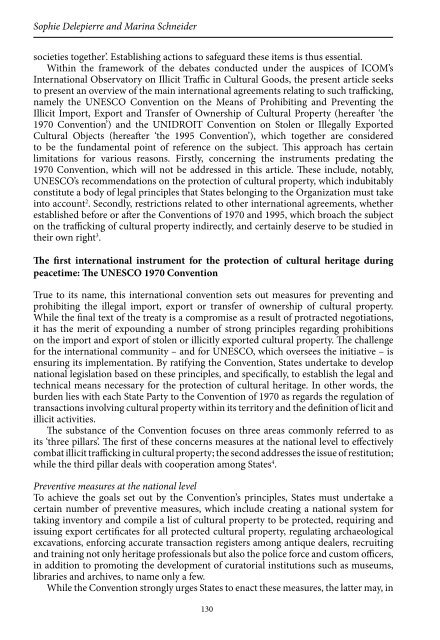Countering
Book_observatory_illicit_traffic_version%20issuu
Book_observatory_illicit_traffic_version%20issuu
Create successful ePaper yourself
Turn your PDF publications into a flip-book with our unique Google optimized e-Paper software.
International Conventions on Illicit Trafficking in Cultural Property<br />
some cases, lack the means to do so. It is in the interest of States to adopt the best possible<br />
national legislation for an effective implementation of the Convention, in order to benefit<br />
from its provisions and, more importantly, to comprehensively protect their heritage.<br />
Prevention is always the best protection. In order to assist the States Parties, UNESCO<br />
and its partner organizations have developed a series of technical tools at the disposal<br />
of States, particularly through the national and regional training UNESCO regularly<br />
organizes 5 . The stated goal of these measures is by no means to restrict the legitimate<br />
trade in cultural property, on the contrary. UNESCO, as a United Nations organization<br />
with mandates both cultural and educational, encourages cultural exchange in all its<br />
forms, insofar as these are fully consensual.<br />
The issue of restitution as concerns stolen cultural property<br />
The second ‘pillar’ of the Convention relates to the restitution of stolen cultural property.<br />
Article 7(b)(ii) of the Convention states that cultural property stolen from a museum or<br />
a religious or secular public monument must be returned to the State from which it was<br />
removed. This rule is, however, subject to several conditions: it must be demonstrated<br />
that the object figures in the institution’s inventory (hence the importance of the<br />
above-mentionned inventory process); the object must have been imported after the<br />
Convention entered into effect in both States Parties involved. Furthermore, the<br />
requesting State must provide ‘just compensation to an innocent purchaser or to a person<br />
who has valid title to that property’. In terms of procedure, requests for restitution must<br />
be sent via diplomatic channels. The requesting State is also obligated to provide all<br />
documents necessary to justify its demand for seizure and restitution.<br />
Together, these criteria make for a relatively limited scope of action, which has<br />
certainly contributed to curtailing the number of restitutions of cultural property under<br />
the auspices of the Convention stricto sensu. Moreover, while the wording of this article<br />
is detailed in some respects, particularly the inventory requirement (which excludes by<br />
itself all archaeological finds exported illegally), it leaves considerable room for variance<br />
in interpretation by experts from differing legal traditions. This tension between stringent<br />
conditions for application and latitude in the wording is evidence of how politically<br />
charged the restitution of cultural heritage is, and how difficult it can be for States to<br />
agree on a text addressing this issue. Should we therefore conclude that the Convention<br />
of 1970 is ineffective when it comes to the restitution of cultural property? Certainly not,<br />
since the Convention has nourished a wealth of thoughtful discussions on international<br />
cooperation both in the realm of culture in general, and issues of restitution in particular.<br />
Over the course of numerous ratifications, and through the development of specialized<br />
legal and technical instruments, the States Parties have expanded the scope of action<br />
for return and restitution that go beyond what the text of the Convention foresees, and<br />
which would not have been possible had it not been adopted.<br />
In 40 years of existence, the 1970 Convention has permitted significant instances of restitution and<br />
helped make cultural property central to cultural cooperation and diplomatic relations.<br />
[Irina Bokova, ‘From Baghdad to Cairo – combating trafficking in cultural property’, in Mondes, Les<br />
cahiers du Quai d’Orsay, n°8, (Autumn, 2011) 81-89.]<br />
Certain requests for return or restitution prove particularly complicated, however,<br />
usually because of highly sensitive political issues. In cases where no bilateral agreement<br />
can be reached, Member States of UNESCO may petition the Intergovernmental<br />
131


